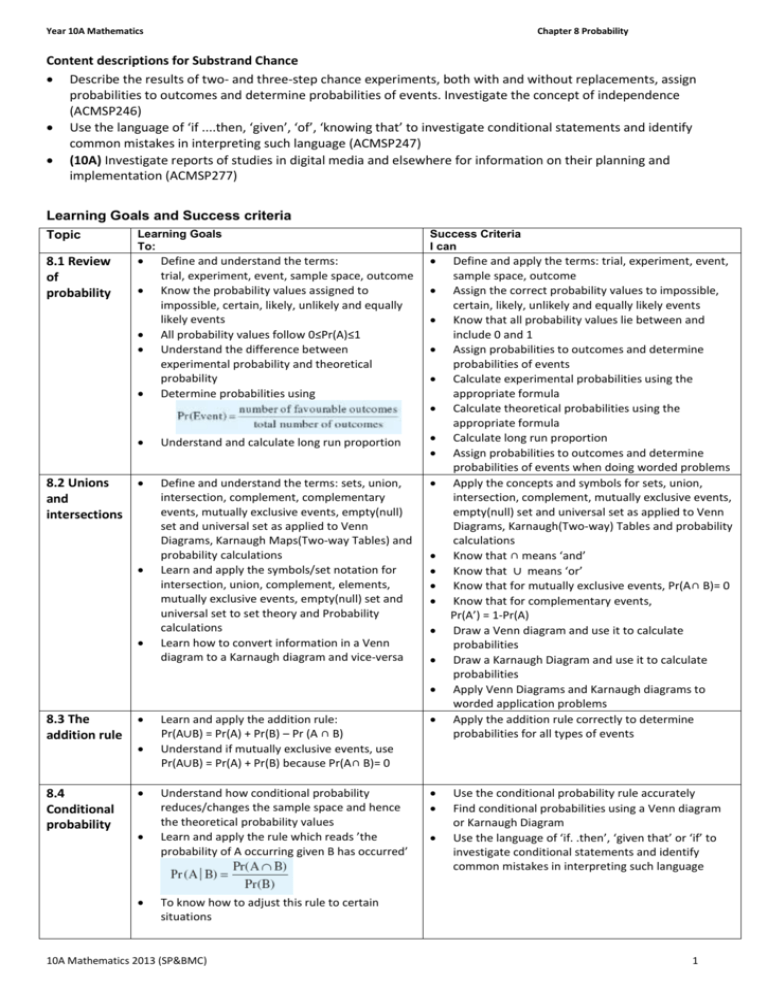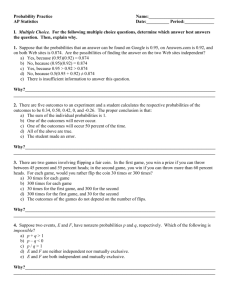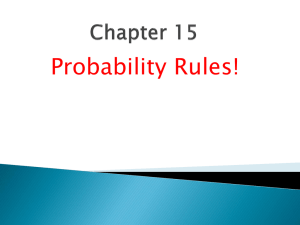File
advertisement

Year 10A Mathematics Chapter 8 Probability Content descriptions for Substrand Chance Describe the results of two- and three-step chance experiments, both with and without replacements, assign probabilities to outcomes and determine probabilities of events. Investigate the concept of independence (ACMSP246) Use the language of ‘if ....then, ‘given’, ‘of’, ‘knowing that’ to investigate conditional statements and identify common mistakes in interpreting such language (ACMSP247) (10A) Investigate reports of studies in digital media and elsewhere for information on their planning and implementation (ACMSP277) Learning Goals and Success criteria Topic Learning Goals To: Success Criteria I can 8.1 Review of probability Define and understand the terms: trial, experiment, event, sample space, outcome Know the probability values assigned to impossible, certain, likely, unlikely and equally likely events All probability values follow 0≤Pr(A)≤1 Understand the difference between experimental probability and theoretical probability Determine probabilities using 8.2 Unions and intersections Understand and calculate long run proportion Define and understand the terms: sets, union, intersection, complement, complementary events, mutually exclusive events, empty(null) set and universal set as applied to Venn Diagrams, Karnaugh Maps(Two-way Tables) and probability calculations Learn and apply the symbols/set notation for intersection, union, complement, elements, mutually exclusive events, empty(null) set and universal set to set theory and Probability calculations Learn how to convert information in a Venn diagram to a Karnaugh diagram and vice-versa 8.3 The addition rule 8.4 Conditional probability Learn and apply the addition rule: Pr(A∪B) = Pr(A) + Pr(B) – Pr (A ∩ B) Understand if mutually exclusive events, use Pr(A∪B) = Pr(A) + Pr(B) because Pr(A∩ B)= 0 Understand how conditional probability reduces/changes the sample space and hence the theoretical probability values Learn and apply the rule which reads ’the probability of A occurring given B has occurred’ Define and apply the terms: trial, experiment, event, sample space, outcome Assign the correct probability values to impossible, certain, likely, unlikely and equally likely events Know that all probability values lie between and include 0 and 1 Assign probabilities to outcomes and determine probabilities of events Calculate experimental probabilities using the appropriate formula Calculate theoretical probabilities using the appropriate formula Calculate long run proportion Assign probabilities to outcomes and determine probabilities of events when doing worded problems Apply the concepts and symbols for sets, union, intersection, complement, mutually exclusive events, empty(null) set and universal set as applied to Venn Diagrams, Karnaugh(Two-way) Tables and probability calculations Know that ∩ means ‘and’ Know that ∪ means ‘or’ Know that for mutually exclusive events, Pr(A∩ B)= 0 Know that for complementary events, Pr(A’) = 1-Pr(A) Draw a Venn diagram and use it to calculate probabilities Draw a Karnaugh Diagram and use it to calculate probabilities Apply Venn Diagrams and Karnaugh diagrams to worded application problems Apply the addition rule correctly to determine probabilities for all types of events Use the conditional probability rule accurately Find conditional probabilities using a Venn diagram or Karnaugh Diagram Use the language of ‘if. .then’, ‘given that’ or ‘if’ to investigate conditional statements and identify common mistakes in interpreting such language To know how to adjust this rule to certain situations 10A Mathematics 2013 (SP&BMC) 1 Year 10A Mathematics 8.5 Multiple events using tables 8.6 Using tree diagrams Chapter 8 Probability Learn to use a table(lattice diagram) to determine a sample space for multiple events Learn the difference between assigning probabilities for events involving selection ‘without replacement’ and ‘with replacement’ Learn to use a tree diagram to determine a sample space for multiple events Use tree diagrams to show the difference between assigning probabilities for events ‘without replacement’ and ‘with replacement’ 8.7 Independent events Define independent events as the outcome of one event not affecting the outcome of another event Know that for independent events Pr(A∩ B)=Pr(A) x Pr(B) Know that for independent events the conditional probability formula becomes Pr(A│B)= Pr(A) Know that independent events involve selection without replacement Know that selection with replacement are not independent events Learn and apply the addition rule to independent events Pr(A∪B) = Pr(A) + Pr(B) – Pr(A) x Pr(B) Vocabulary To be able to understand and use the following mathematical terms: trial, experiment, event, sample space, outcome, universal set, impossible, certain, likely, unlikely and equally likely events, long run proportion, experimental probability, theoretical probability, intersection, union, empty(Null) set, Venn diagrams, Karnaugh diagrams (two-way tables), Lattice diagrams, Tree diagrams, multiple events, independent events, mutually exclusive events, conditional probability, selection ‘with replacement’ and selection ‘without replacement’ 10A Mathematics 2013 (SP&BMC) Use a table( Lattice diagram) to determine a sample space for multiple events assign probabilities for events involving selection ‘without replacement’ and ‘with replacement’ Use a tree diagram to determine a sample space for multiple events Use a tree diagram to accurately assign probabilities for events ‘without replacement’ and ‘with replacement’ Use tree diagrams to accurately assign probabilities and hence solve application problems Use tree diagrams, Venn diagrams, Karnaugh diagrams, the conditional probability rule and the addition rule accurately to solve application problems involving independent events I can understand and use vocabulary related to Probability and Venn Diagrams 2








![Set Notation my notes TYPED[7]](http://s3.studylib.net/store/data/006729206_1-a82ac68e1e71612ef4027b80fd20cc6f-300x300.png)